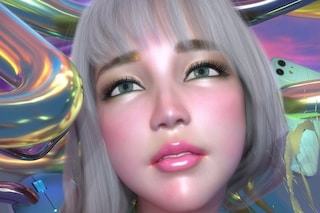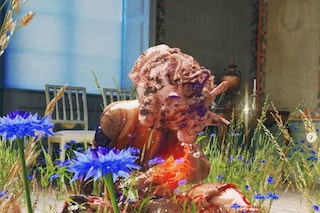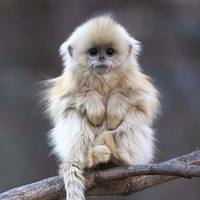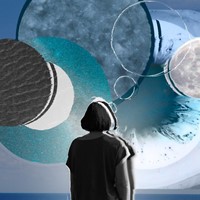From Nyan cats to sex tapes and Beeple, nonfungible tokens are the latest craze taking over the art world – but are they worth the hype?
The buzz came slowly, and then all at once. First it was the Nyan Cat meme, which sold for $590,000. Then it was Grimes selling her artworks. Another $6 million. Next thing you know, an artist called Beeple sells an animated gif of Trump’s naked corpse for $6.6 million, setting a new record for the most expensive piece of digital art ever. Christie’s launches a two-week sale of one of his works. It’s already broken the record again at an unprecedented $69 million. The third-highest auction price achieved for a living artist, after Jeff Koons and David Hockney.
We are, of course, talking about NFTs – nonfungible tokens – the latest craze taking over the art world, and our minds. From niche interest to global obsession, these digital collectibles use blockchain technology to give buyers ownership over a single object such as a digital artwork or photograph. At the time of writing this, Twitter founder Jack Dorsey is auctioning off the world’s first-ever tweet as an NFT and Azealia Banks has sold a sex tape with her artist boyfriend for $17,000. Even Taco Bell is hopping on the hype by selling taco-themed GIFs on NFT marketplace Rarible – because why buy real tacos when you can stare at a simulation of one on your screen?
Built on blockchain and bought using cryptocurrencies like Ethereum, these digital tokens are uniquely identifiable and all transactions, sales, and transfers related to this work are visible to the public. Whereas before, you could right-click and save a digital asset and technically claim it and use it as yours, the blockchain is proof that a NFT collector owns a piece. This allows for scarcity and clear ownership in the digital domain, which wasn’t possible before.
While this might seem utopian, some critics of NFTs claim it’s propagating the same old pitfalls of the art world and digital companies like Facebook and Instagram. NFTs present a decentralised marketplace independent of the art establishment, but a majority of people buying and selling NFTs are reliant on platforms, which takes significant cuts of money.
Websites like the now-defunct cryptoart.wtf have also drawn attention to the catastrophic impact of NFTs on the environment. According to artist Memo Atken, just one NFT is accountable for an astounding 211kg of CO2 emissions, equal to driving a car for over 600 miles.
Below, we speak to four digital artists – Aaron Jablonski, Eva Papamargariti, Sucuk & Bratwurst, and Nicole Ruggiero – on the benefits and drawbacks of NFTs, and whether they live up to the hype.
EVA PAPAMARGARITI
“NFTs definitely give artists a certain sense of autonomy in terms of creating and distributing their work. There is a new kind of visibility arising for digital art, especially for some works that were very difficult to become part of a selling market such as those that use generative coding. Artists gain more control of their work which now seems that can finally be seen, it can also be tracked and of course it can be traded without the necessity or interference of an institution, museum, or gallery.
“There is no actual gatekeeping from any kind of older mechanism and establishment, the artist is flexible to choose how and when they can distribute their work. At this exact moment, NFT platforms feel like an open sea where possibilities seem endless. But, like in an open sea, many tricky situations can occur too.
“The NFT world is fragmented. We become viewers and collectors of small extracts, images, animations, older works become visible again and get another chance of circulating themselves in the metaverse, things can equally become fascinating and flat at once. I think it is quite useful to take a step back and watch the situation from afar sometimes, examine it and approach it with a kind of thoughtfulness instead of an ongoing relentless ecstasy.”
“NFTs are linked with the notions of value, ownership, authenticity. Crypto-art exudes a certain degree of transparency, the origins and traces of each token are visible and artists continue to get a percentage after each sale due to the blockchain protocols. While the idea of uniqueness becomes the dominant force that defines these objects and their aura, at the same time, there is an ongoing rising wave of economic speculation and inflation that surrounds NFTs that we cannot ignore.
“Art is re-examining its own mechanisms of existing, but I wonder if this is an actual shift that can shake power structures that dominate the art field, or if it is just another version of the same game. I am really happy to see artists getting together, forming a kind of community in the world of NFTs and crytomedia, and excited to see different kinds of networks, rising in this context, that support BIPOC and LGBTQIA artists.
“I think that these decentralised platforms can bring a new sense of communing and understanding to the world of art and this can only be positive and utterly desirable. But we shouldn't ignore the fact that the promise of an actual change needs to take into consideration many aspects like, economic pyramid structures, money circulation, environmental impact, inclusivity to name a few. Art is not in need of a model that looks novel but repeats the mistakes of the older system and structures. I believe we should aim towards a diverse model of thinking and action instead.”
AARON JABLONSKI
“Blockchains are basically huge global supercomputers that can run algorithms on them. These are often referred to as Smart Contracts and through these mechanisms it can be ensured that the original creator of the piece will be paid a predefined royalty each time a work resells – forever. This is something unique to this space – if someone sells an artwork on a traditional market and then grows as an artist in their career it might be that the collector can resell it for a much higher value but the original artist would never profit from their work again. With NFTs, they would get a share with each sale on the secondary market.
“Last week I had a successful release on a platform called DontBuyMeme with four VR sculpted digital sculptures. On this platform you stake their own crypto currency $MEME over a certain amount of time and then get the chance to ‘farm’ the artworks. This differs from the approach of other crypto art platforms and is a combinatory approach of DeFi (Decentralised Finance) and digital art.
In general, I would say this whole space is in a crazy state right now and I think no one can really predict where this is going. It’s definitely not easy to make yourself known in the space but if you keep at it and release artworks consistently then it’s definitely still possible to enter and slowly build your community of collectors. All the big platforms are flooded with applications right now and it’s quite hard to get in at this point. But there are other platforms where you can just release your art openly (Rarible, Opensea) and do really well if people discover you. It’s all quite unpredictable, I’d say.”
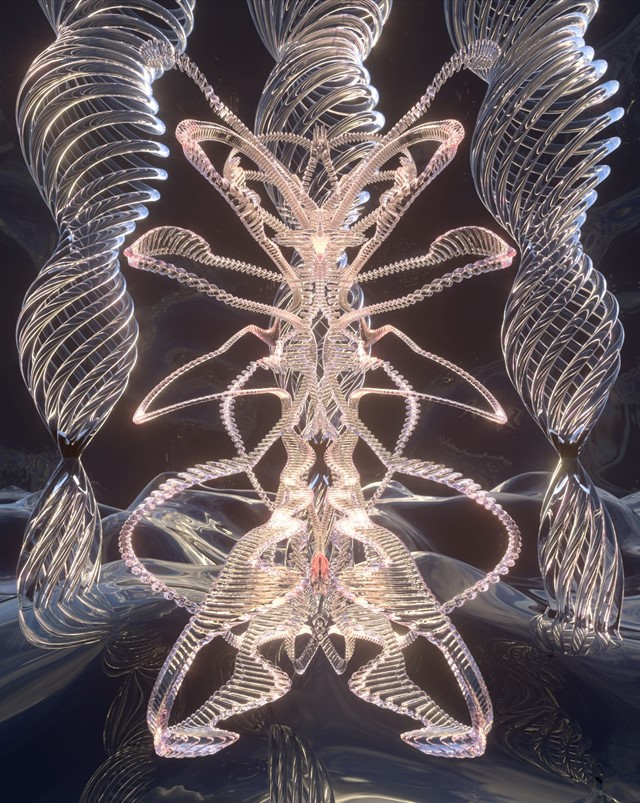
“NFTs can definitely be empowering to creators but of course it has downsides, too. If you enter this space and put your work up for sale on these markets then you essentially invite people to speculate with your art. Some people might only want to get your pieces to be able to resell it for a big margin some time later. A good example for this are pieces of crypto-art superstars like Beeple.
“Another downside are the ecological implications. The problem lies in blockchain itself, not in crypto-art (which takes place on the blockchain). The two biggest chains, Bitcoin and Ethereum, are both very unsustainable and consume an insane amount of energy because their mechanism of verifying transactions is actually based on complex calculations that need lots of processing power. This is an important topic to address and discuss, but Ethereum, for example, has been working towards changing their consensus algorithm for years now and it will happen eventually. There are already blockchains available that are way more sustainable and also offer the functionality to mint NFTs.
“It’s a complex topic and I think it’s important to see both sides because it strikes me as slightly hypocritical that everyone is talking about the ecological downsides of crypto-art now that artists are making money and have the chance to become independent from big clients and corporations. Blockchain has existed like this for many years. The alternative is either becoming successful enough with your art that you can live from that alone, which only a fraction of artists can do, or sell your creative energy to clients and ad campaigns. I wonder how ecologically sustainable these are?
“It’s a really fascinating field and the technology behind it is solid and has been proven to work - I think when these ecological issues are being addressed this can really become a disruptive technology that is definitely here to stay. It will change digital art and media in general forever. Everything will be a NFT, from assets in video games, to music and digital art, to tickets and events.”
SUCUK & BRATWURST
“NFTs are the first real opportunity to self market your art without losing any money to the art industry like galleries or similar. The usual way to make money as a digital artist is to get booked for artwork commissions by brands or musicians. Now you can also start to live off your own vision and the art you want to make personally without any restrictions or boundaries. Also the intellectual value of digital artworks gets more established and recognised.
“NFTs provide a great opportunity to follow your own vision and also profit from it. While “personal” digital artworks used to live on your portfolio or instagram just for the exposure, you now to a certain degree have the opportunity to gain financial freedom by solely making your art. At the current state however the NFT world regarding digital artworks already feels kind of saturated from a pure visual standpoint. NFTs and Crypto art became kind of an art genre itself similar to the post internet art phenomenon. It will be exciting to see where the majority of crypto art will head besides being “oddly satisfying”. Maybe the problem with digital art in general was, because social media was the main environment it lived in until now, that its quality was measured in likes and hype. And the fast paced nature of social media favoured aesthetics over anything else. It will be interesting to see if the nft art market will change that and in what way.”

“The downsides are the environmental impact that comes with the computation that is needed for the block chain. Although it must be said that “traditional” art on the other hand also is far away from being free of any environmental impact thinking of productions/transportation/distribution. So maybe that point is a bit invalid to be a real downside. Another downside is that it’s hard to build a reputation working with the different platforms algorithms. Artists that already have a huge following on other socials can profit pretty easily with the use of NFTs while it can sure be difficult to benefit from NFTs if you are just starting out or making original and unique artworks but lack the following.
“Pure digital fashion will of course get a lot bigger and more advanced. May it be NFTs related to certain game Skins or for example a potential “supreme digital only collection” distributed through NFTs. The kind of hybrid mechanic of a Fundable Token that can be traded similar to a NFT and rewarded and exchanged only once with a real product is also a really great concept.”
NICOLE RUGGIERO
“Digital artists are finally being compensated for the work that we’ve been putting out for free for years. Until now, most digital artists haven’t been able to make money off of their work. I have personally created mostly all my work for free, including huge exhibitions that have traveled internationally for little to no compensation. Instead just benefitting media companies, who make money off it through tangential advertising, we are now able to be directly compensated.
“I have been loving being able to sell my work as NFTs. I am currently on the platforms Foundation and Zora @nicoleruggiero. I am really grateful to be a part of this new digital movement. It feels really liberating to finally be able to be compensated for my work directly. It allows me to be able to focus even more on my work and the meaning behind it, and I find that so exciting. I think a lot of other artists feel the same right now. It feels like there has been a renewal of energy within the 3D community. I am seeing new, exciting work from friends and reconnecting with people in a way that I haven’t since the mid 2010s.
“But there are a lot of ecological concerns right now. NFTs and crypto transactions create carbon emissions through the mining process. The main issue is if crypto transactions are using clean energy sources. To me, this is a larger issue of energy sources in general. I am a proponent of clean energy ranging from wind and solar to some safer methods of nuclear (thorium reactors). I have also been donating to offset my emissions. This is not a catch-all solution. I think everyone should also consider contacting their local energy company and inquire about switching to clean energy. It usually costs a bit more, but the environmental impact is a lot less. I am going to do the same as soon as I can afford to do so and I will continue to donate and be aware of my own emissions in the space.”


